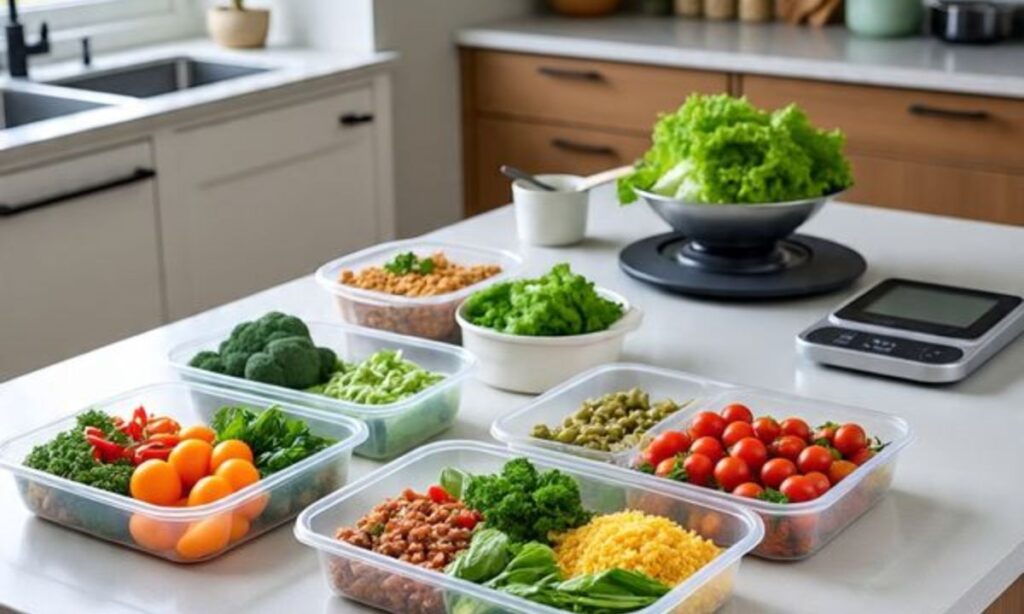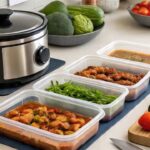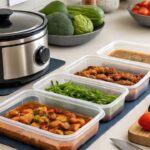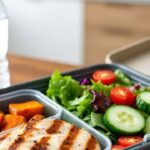Proper meal prep isn’t just about cooking in bulk — it’s about getting portions right. Correct portioning helps maintain balanced nutrition, control calorie intake, and prevent food waste. Whether you’re meal prepping for weight loss, muscle gain, or simply convenience, learning to portion meals correctly is essential.
Why Proper Portioning Matters
- Promotes healthy eating habits
- Helps manage weight effectively
- Prevents overeating
- Saves time and money
- Ensures balanced nutrition
Step-by-Step Guide to Portion Meals Correctly
1. Understand Your Nutritional Needs
Every person’s requirements differ based on age, gender, weight, and activity level. Use a calorie calculator or consult a nutritionist to estimate your daily needs.
Tip: Divide your daily calorie goal by the number of meals you plan to prep to figure out each portion size.
2. Use the Plate Method
A simple and effective approach:
- ½ plate vegetables or salad
- ¼ plate lean protein (chicken, fish, tofu, beans)
- ¼ plate whole grains or starchy foods (brown rice, quinoa, potatoes)
3. Measure Your Food
Invest in measuring tools like kitchen scales, measuring cups, and spoons. This ensures you’re accurate with:
- Grams of protein
- Cups of vegetables
- Ounces of carbs
4. Pre-Portion Before Storing
Instead of storing large containers, divide meals into individual containers right after cooking. This prevents overeating and makes grab-and-go easier.
5. Use Portion-Control Containers
Color-coded or labeled containers make it simple to separate proteins, carbs, and fats.
6. Adjust Portions Based on Goals
- For weight loss: Slightly reduce carbs or fats.
- For muscle gain: Increase protein and complex carbs.
- For maintenance: Balance all macros equally.
Table: Recommended Portion Sizes by Food Group
| Food Group | Recommended Portion per Meal | Example Foods |
|---|---|---|
| Protein | 3–4 oz (about the size of your palm) | Chicken, fish, tofu, eggs |
| Vegetables | 1–2 cups (half your plate) | Broccoli, spinach, mixed greens |
| Carbohydrates | ½–1 cup (fist-sized) | Brown rice, quinoa, sweet potato |
| Healthy Fats | 1–2 tbsp | Olive oil, nuts, seeds, avocado |
| Fruit (optional) | ½–1 cup | Berries, apples, oranges |
Tips for Maintaining Proper Portions
- Pre-plan your meals with a weekly menu.
- Label containers with calorie or macro info.
- Avoid eating directly from large containers.
- Reassess portions regularly based on weight or activity changes.
Common Portioning Mistakes to Avoid
- Skipping vegetables to save time
- Overloading carbs and underestimating calories
- Using oversized containers that distort your sense of portion size
- Forgetting to measure cooking oils and dressings
FAQs
Q1. How many meals should I prep at once?
Most people prep 3–5 days’ worth of meals at a time. Beyond that, food may lose freshness.
Q2. Do I need a food scale to portion meals?
While not mandatory, a food scale improves accuracy, especially if you’re tracking calories or macros.
Q3. Can I freeze pre-portioned meals?
Yes. Freezing is ideal for meals beyond 3 days. Just ensure airtight containers to prevent freezer burn.
Q4. How do I portion snacks?
Use small bags or containers and pre-measure servings (nuts, fruits, yogurt) to avoid mindless eating.
Q5. Should portion sizes change for exercise days?
Yes. On high-activity days, you may increase carbs slightly to fuel your workouts.
Key Takeaways
- Know your daily calorie and macro needs.
- Use measuring tools and portion-control containers.
- Plan and label meals in advance.
- Adjust portions as your goals evolve.
Final Thoughts
Portioning meals correctly is the backbone of successful meal prep. It helps you stay on track with your health goals, ensures balanced nutrition, and makes your week smoother. With a little planning, measuring, and consistency, you can turn meal prep into an easy, sustainable habit.





